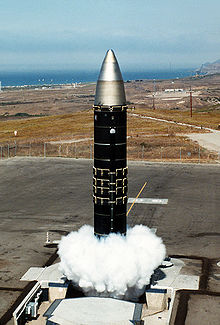
Back إل جي إم 118 بيسكيبر Arabic LGM-118 Czech LGM-118 Peacekeeper German LGM-118A Peacekeeper Esperanto LGM-118A Peacekeeper Spanish الجیام-۱۱۸ پیسکیپر Persian LGM-118A Peacekeeper Finnish Peacekeeper (missile balistique) French MX Irish LGM-118 Peacekeeper ID
| LGM-118 Peacekeeper | |
|---|---|
 Test launch of a Peacekeeper ICBM by the 1st Strategic Aerospace Division (1 STRAD), Vandenberg AFB, CA (USAF) | |
| Type | Intercontinental ballistic missile |
| Place of origin | United States |
| Service history | |
| In service | December 1986[1] — 12 September 2005[2] |
| Used by | United States Air Force |
| Production history | |
| Manufacturer |
|
| Unit cost | US$70,000,000 (equivalent to $194,571,949 in 2023) |
| Specifications | |
| Mass | 87,750 kg 193,460 lb[3] |
| Length | 21.8 m 72 ft[3] |
| Diameter | 2.34 m 7.7 ft[3] |
| Warhead | Up to 11 Avco Mk21 re-entry vehicles each carrying a 300 kt W87-0 warhead (though in practice, only 10 were carried); or 12 Avco Mk12A re-entry vehicles each carrying a 335–350 kt W78 warhead (never deployed)[4] plus decoys |
Detonation mechanism | Ground-burst and/or air-burst fusing modes |
| Engine |
First stage: 500,000 pounds-force (2.2 MN) |
Operational range | 6,000 mi (9,600 km)[5]: 288 [3]-8,700 mi (14,000 km)[6][7] |
| Maximum speed | Approximately 15,000 miles per hour (Mach 20; 24,000 km/h) at burnout[1] |
Guidance system | Inertial (AIRS) |
| Accuracy | 130 ft (40 m)[8][9]-300 ft (90 m) CEP[3] |
Launch platform | Fixed silo |
The LGM-118 Peacekeeper, originally known as the MX for "Missile, Experimental", was a MIRV-capable intercontinental ballistic missile (ICBM) produced and deployed by the United States from 1985 to 2005. The missile could carry up to twelve Mark 21 reentry vehicles (although treaties limited its actual payload to 10), each armed with a 300-kiloton W87 warhead. Initial plans called for building and deploying 100 MX ICBMs, but budgetary concerns limited the final procurement; only 50 entered service. Disarmament treaties signed after the Peacekeeper's development led to its withdrawal from service in 2005.
Studies on the underlying concept started in the 1960s. The idea was to allow the U.S. to absorb a sneak attack by the USSR with enough warheads surviving to attack the remaining Soviet missile silos. To do so, the missiles had to be highly accurate, be based in such a way that enough would survive a nuclear attack, carry a large number of warheads so the survivors would still inflict massive damage, and be able to rapidly re-target so they could be aimed at only those missiles the Soviets had not yet fired. Over its development through the 1970s, MX emerged as a highly accurate, rapid-firing, and quickly retargeted system. Ultimately, the only problem that was never completely solved was the issue of basing.
Initial development began in 1971, with full-scale development starting in 1974. President Jimmy Carter ordered initial production in 1979 but was overturned by Congress. After considerable debate about the system, in October 1982, President Ronald Reagan announced that 50 of the newly named Peacekeepers would be put into service in existing LGM-30 Minuteman silos, a temporary measure until final basing was decided. The first flight test took place in 1983, which included the successful launch of six inert re-entry vehicles, each hitting pre-planned targets. It was the first U.S. ICBM to use a cold launch system.
Peacekeeper reached initial operational capability in 1986. At this time, the United States and the Soviet Union were negotiating the START II treaty, under which ICBMs were allowed to carry only a single warhead each. Because the Minuteman could carry a single warhead for far less money, the United States agreed to remove the Peacekeeper from their nuclear force in this treaty. Despite the U.S. withdrawal from the Anti-Ballistic Missile Treaty and the subsequent Russian withdrawal from the START II on 14 June 2002, the last Peacekeeper missile was deactivated on 19 September 2005. Their advanced W87 warheads were moved to the Minuteman III.
The private launch firm Orbital Sciences Corporation has developed the Minotaur IV, a four-stage civilian expendable launch system using old Peacekeeper components. As of 2020[update], seven Minotaur IV flights have been made.
- ^ a b Cite error: The named reference
FAS_2000was invoked but never defined (see the help page). - ^ Cite error: The named reference
Boese_200510was invoked but never defined (see the help page). - ^ a b c d e Cite error: The named reference
MisslieThreat_2021was invoked but never defined (see the help page). - ^ Cite error: The named reference
PalbaCz_2007was invoked but never defined (see the help page). - ^ Cite error: The named reference
Heginbotham_2015was invoked but never defined (see the help page). - ^ "Peacekeeper Missile". 5 September 2015.
- ^ https://www.weapontrend.com/nuclear-weapon-manufacturer-countries/usa/lgm-118-peacekeeper.html
- ^ "Peacekeeper Missile". 5 September 2015.
- ^ https://www.weapontrend.com/nuclear-weapon-manufacturer-countries/usa/lgm-118-peacekeeper.html
© MMXXIII Rich X Search. We shall prevail. All rights reserved. Rich X Search